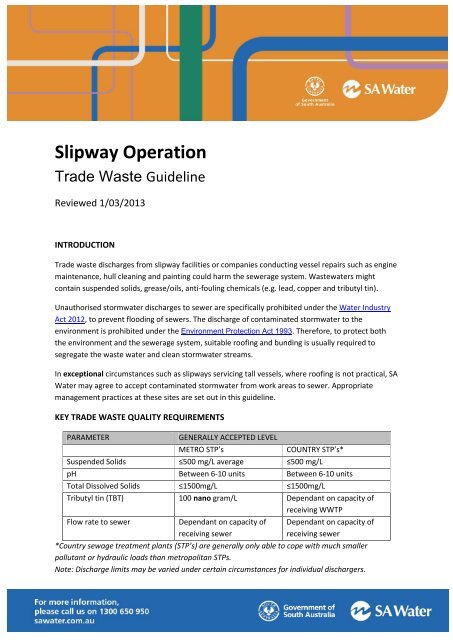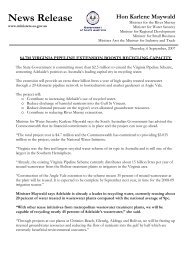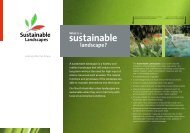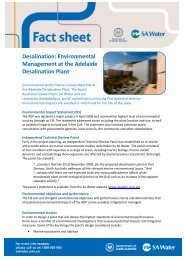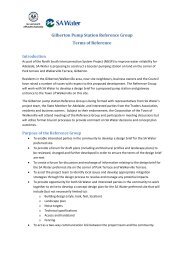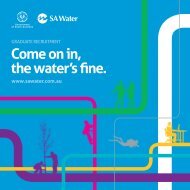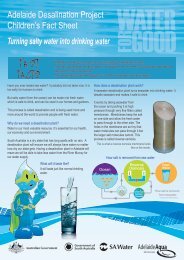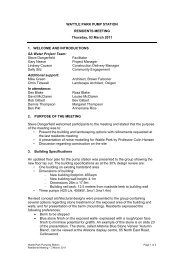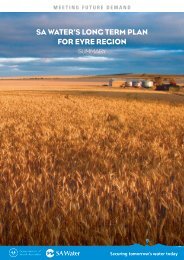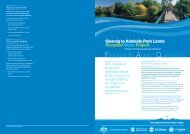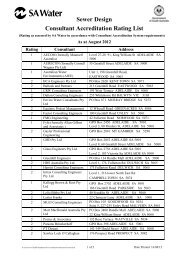Slipway Operation - SA Water
Slipway Operation - SA Water
Slipway Operation - SA Water
You also want an ePaper? Increase the reach of your titles
YUMPU automatically turns print PDFs into web optimized ePapers that Google loves.
<strong>Slipway</strong> <strong>Operation</strong><br />
Trade Waste Guideline<br />
Reviewed 1/03/2013<br />
INTRODUCTION<br />
Trade waste discharges from slipway facilities or companies conducting vessel repairs such as engine<br />
maintenance, hull cleaning and painting could harm the sewerage system. Wastewaters might<br />
contain suspended solids, grease/oils, anti-fouling chemicals (e.g. lead, copper and tributyl tin).<br />
Unauthorised stormwater discharges to sewer are specifically prohibited under the <strong>Water</strong> Industry<br />
Act 2012, to prevent flooding of sewers. The discharge of contaminated stormwater to the<br />
environment is prohibited under the Environment Protection Act 1993. Therefore, to protect both<br />
the environment and the sewerage system, suitable roofing and bunding is usually required to<br />
segregate the waste water and clean stormwater streams.<br />
In exceptional circumstances such as slipways servicing tall vessels, where roofing is not practical, <strong>SA</strong><br />
<strong>Water</strong> may agree to accept contaminated stormwater from work areas to sewer. Appropriate<br />
management practices at these sites are set out in this guideline.<br />
KEY TRADE WASTE QUALITY REQUIREMENTS<br />
PARAMETER<br />
GENERALLY ACCEPTED LEVEL<br />
METRO STP’s<br />
COUNTRY STP’s*<br />
Suspended Solids ≤500 mg/L average ≤500 mg/L<br />
pH Between 6-10 units Between 6-10 units<br />
Total Dissolved Solids ≤1500mg/L ≤1500mg/L<br />
Tributyl tin (TBT) 100 nano gram/L Dependant on capacity of<br />
receiving WWTP<br />
Flow rate to sewer<br />
Dependant on capacity of<br />
receiving sewer<br />
Dependant on capacity of<br />
receiving sewer<br />
*Country sewage treatment plants (STP’s) are generally only able to cope with much smaller<br />
pollutant or hydraulic loads than metropolitan STPs.<br />
Note: Discharge limits may be varied under certain circumstances for individual dischargers.
DESIGN/INSTALLATION<br />
Ballast, bilge and seawaters are prohibited from discharge to sewer. These must be removed<br />
by a licensed liquid waste contractor for off-site treatment and disposal.<br />
The slipway, cleaning and wash down facility design minimises the area that is unroofed and<br />
the facility is used only for cleaning marine growth from the hull.<br />
The facility is bunded to contain all wash down water and exclude clean stormwater runoff<br />
from entering the slipway, in accordance with Trade Waste Bunding and Blind Tank<br />
Guideline.<br />
Wash water and initial, ‘first flush’ stormwater falling on the ‘dirty’ area will be accepted to<br />
sewer after appropriate pre-treatment. The Environment Protection Authority (EPA)<br />
recommends a 10mm first flush volume, but this might vary at individual sites. A rain gauge<br />
coupled to the control panel monitors rainfall events.<br />
When a rainfall event exceeds the ‘first flush’ amount, further stormwater flow is<br />
automatically directed away from sewer to the stormwater drain. Activities likely to<br />
introduce new contamination during rainfall events are not permitted.<br />
Discharge of collected wash water and ‘first flush’ rainfall to sewer is delayed until after a<br />
rainfall event has passed to avoid flooding of the sewer.<br />
Solids from work areas of slipway are removed by dry cleaning/sweeping prior to wash<br />
down.<br />
All tanks containing the waste water and treatment chemicals are bunded in accordance<br />
with Trade Waste Bunding and Blind Tank Guideline.<br />
TYPICAL PRE-TREATMENT<br />
All wash water and contaminated “first flush” stormwater is directed to sewer via;<br />
A suitably sized screening device (silt trap and/or screen with maximum 5mm size mesh)<br />
discharging via a stormwater bypass chamber to a pump chamber.<br />
A float operated pump transfers waste water to the settling tank.<br />
A chemical addition system (e.g. coagulants and flocculants) dosing into the solids settling<br />
tank, to aid separation, if the suspended solids, heavy metals, or other contaminant<br />
concentrations exceed the Restricted Wastewater Acceptance Standards.<br />
Wastewater from the settling pit overflows to a holding tank big enough to hold the ‘first<br />
flush’. A solenoid valve on the outlet, coupled to a control panel, opens once the stormwater<br />
‘peak flow’ has passed the site, discharging waste water to the sewer at a controlled, slow<br />
rate.<br />
All clean stormwater (i.e. that falling after the ‘first flush’) is diverted away from sewer and<br />
discharged to the stormwater system.<br />
See Figure 1 for a typical layout of a contaminated stormwater treatment system.<br />
ADDITIONAL PRE-TREATMENT<br />
Balance tanks for wastewater storage may be required depending on the hydraulic capacity<br />
of the local sewer network or STP.<br />
An oil water separator will be required if any oily waste waters (e.g. engine maintenance)<br />
discharge into the system.<br />
Where antifouling paint containing Tributyl tin (TBT) may be applied or removed, all<br />
supernatant is discharged to sewer via a Granulated Activated Carbon (GAC) bed. The GAC<br />
will require replacement as the concentration of TBT nears the 100 nano-gram per litre<br />
discharge limit.
MAINTENANCE<br />
It is the responsibility of site management to ensure the effective operation of all pre-treatment<br />
equipment (e.g. ongoing removal of accumulated solids, sludge removal, chemical replacement.)<br />
An appropriate maintenance program is needed, to test that the entire diversion and pre-treatment<br />
system operates correctly.<br />
FEES AND CHARGES<br />
An annual fee for discharge of stormwater to sewer will apply. A current fee schedule is obtainable<br />
from the Trade Waste Branch.<br />
MORE INFORMATION<br />
Mains <strong>Water</strong> Protection (AS/NZS3500-2003 Part 1)
Figure 1: Contaminated stormwater treatment and diversion system<br />
Control<br />
Panel<br />
Rain Gauge<br />
Wash water supply<br />
controlled by sensors<br />
in treated wastewater<br />
tank.<br />
Appropriate pre-treatment<br />
device(s) (e.g. oil separator,<br />
solids separation, chemical<br />
treatment)<br />
High & low<br />
level<br />
sensors<br />
Tap<br />
Overflow to<br />
stormwater<br />
system<br />
Pump<br />
Treated<br />
wastewater<br />
storage tank<br />
To<br />
Sewer<br />
Channel(s) fitted<br />
with mesh screen<br />
or silt trap<br />
Stormwater<br />
Diversion<br />
Chamber with a<br />
high level overflow<br />
to stormwater and<br />
float switch to<br />
operate pump.<br />
Bunding around<br />
perimeter of wash<br />
down and treatment<br />
system


